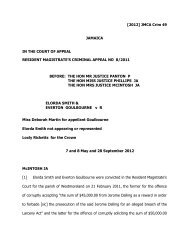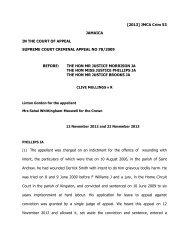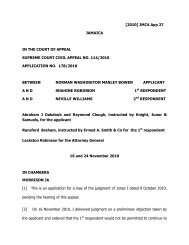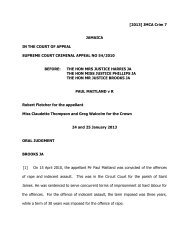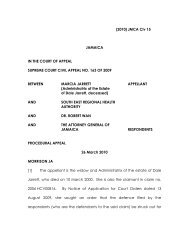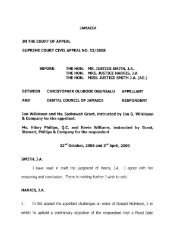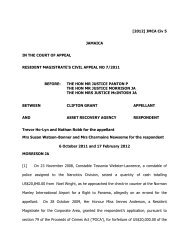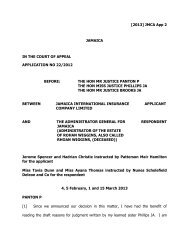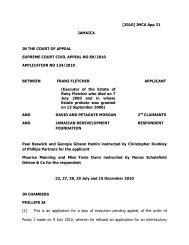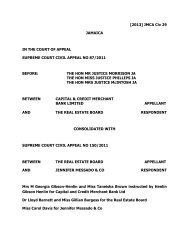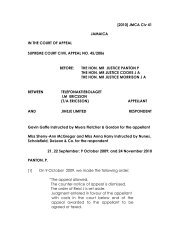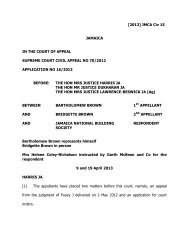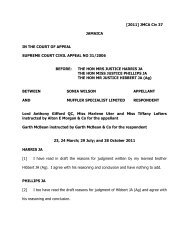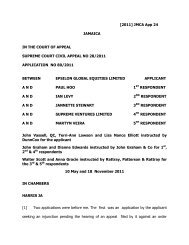Cole's Farm Store Ltd v China Motors Ltd.pdf - The Court of Appeal
Cole's Farm Store Ltd v China Motors Ltd.pdf - The Court of Appeal
Cole's Farm Store Ltd v China Motors Ltd.pdf - The Court of Appeal
- No tags were found...
Create successful ePaper yourself
Turn your PDF publications into a flip-book with our unique Google optimized e-Paper software.
[2012] JMCA App 8JAMAICAIN THE COURT OF APPEALAPPLICATION NO 26/2012BETWEEN COLE’S FARM STORE LTD APPLICANTAND CHINA MOTORS LTD RESPONDENT2 May 2012(Considered on paper pursuant to rule 2.10 <strong>of</strong> the <strong>Court</strong> <strong>of</strong> <strong>Appeal</strong> Rules2002)IN CHAMBERSBROOKS JA[1] <strong>The</strong> applicant, Cole’s <strong>Farm</strong> <strong>Store</strong> <strong>Ltd</strong>, seeks an order permitting substitutedservice, on the respondent, <strong>China</strong> <strong>Motors</strong> <strong>Ltd</strong>, <strong>of</strong> an application for extension <strong>of</strong> timewithin which to file an appeal.[2] <strong>The</strong> applications have their genesis in a judgment <strong>of</strong> Campbell J in the Supreme<strong>Court</strong>. Campbell J had reduced his decision and reasons therefor, to writing. In thatjudgment, the learned trial judge made awards in favour <strong>of</strong> the applicant.
[3] Subsequent to the delivery <strong>of</strong> the judgment, however, the applicant sought tohave certain aspects <strong>of</strong> the judgment clarified. <strong>The</strong>se issues included the question <strong>of</strong>interest on some items <strong>of</strong> special damages and the question <strong>of</strong> costs. According to theapplicant, its attorneys-at-law wrote to the learned trial judge seeking clarification, butthey have had no response to date. In the absence <strong>of</strong> a response from the learned trialjudge, the applicant has prepared no formal order in respect <strong>of</strong> the judgment. <strong>The</strong>affidavit evidence, filed in support <strong>of</strong> the application, suggests that the respondent hasalso not served any formal order <strong>of</strong> the judgment, on the applicant.[4] According to the applicant’s attorneys-at-law, while awaiting a response fromCampbell J, the time for filing the applicant’s notice and grounds <strong>of</strong> appeal elapsed. Asa result, the applicant filed an application for extension <strong>of</strong> time to file the notice andgrounds <strong>of</strong> appeal.[5] A date was fixed for the hearing <strong>of</strong> that application by the full court, but theapplicant has been experiencing challenges in serving the respondent with theapplication and the affidavit in support there<strong>of</strong>. Mrs Janet Taylor, on behalf <strong>of</strong> theapplicant, has deposed that the documents were served on the respondent’s attorneysat-lawby post, but at the time <strong>of</strong> the hearing, the respondent was neither present norrepresented.[6] Since that time, other dates have been set and the results have been the same.Mrs Taylor deposed that the respondent has ceased operating at the two locations, at
which, to the knowledge <strong>of</strong> the applicant, they previously operated.One <strong>of</strong> thoselocations is still the respondent’s registered <strong>of</strong>fice.[7] In order to overcome the difficulties <strong>of</strong> service, the applicant has filed thepresent application seeking orders permitting substituted service. It wishes to serve theapplication to extend time, by two publications <strong>of</strong> the notice <strong>of</strong> proceedings in the DailyGleaner newspaper, seven days apart.<strong>The</strong> time for filing the notice <strong>of</strong> appeal[8] Although this is not the substantive application, in my view, the presentapplication raises the question <strong>of</strong> whether the time for filing the notice and grounds <strong>of</strong>appeal has, in fact, expired. Although the applicant is <strong>of</strong> the view that the time hasexpired, I was not convinced that that was, in fact, so. Submissions in respect <strong>of</strong> theissue were requested <strong>of</strong> the applicant’s attorneys-at-law. <strong>The</strong>ir response, by way <strong>of</strong> aletter, was that rule 1.11(1)(c) <strong>of</strong> the <strong>Court</strong> <strong>of</strong> <strong>Appeal</strong> Rules 2002 (the COAR), dealingwith the time for filing and serving a notice <strong>of</strong> appeal, would not assist the applicant. Ifound the response unhelpful.[9] I have therefore embarked on an analysis <strong>of</strong> the question without the benefit <strong>of</strong>assistance from counsel from either side.<strong>The</strong> examination <strong>of</strong> the issue requiresreference to both the COAR and the Civil Procedure Rules 2002 (the CPR).
Analysis[10] As mentioned before, rule 1.11(1) <strong>of</strong> the COAR deals with the time for filing andserving a notice <strong>of</strong> appeal. <strong>The</strong> rule states:“<strong>The</strong> notice <strong>of</strong> appeal must be filed at the registry and servedin accordance with rule 1.15 -(a) in the case <strong>of</strong> a procedural appeal, within 7 days <strong>of</strong> thedate the decision appealed against was made;(b) where permission is required, within 14 days <strong>of</strong> the datewhen permission was granted; or(c) in the case <strong>of</strong> any other appeal within 42 days <strong>of</strong> thedate when the order or judgment appealed against wasserved on the appellant.” (emphasis supplied)It will have been noticed that each paragraph provides its own trigger as to when timebegins to run. I have emphasised the point concerning service, because in my view, itis critical to deciding this issue.[11] <strong>The</strong> rule just quoted, refers to rule 1.15 <strong>of</strong> the COAR. Rule 1.15, in turn, statesthat the provisions <strong>of</strong> parts 5 and 6 <strong>of</strong> the CPR apply to the issue <strong>of</strong> service <strong>of</strong> notices <strong>of</strong>appeal. Rule 1.1(10)(g) <strong>of</strong> the COAR also provides for the application <strong>of</strong> part 6 <strong>of</strong> theCPR to appeals to this court. I now turn to the relevant provisions in the CPR.[12] Part 5 <strong>of</strong> the CPR is mainly concerned with the service <strong>of</strong> the forms by whichclaims are commenced (claim forms).It speaks to the methods <strong>of</strong> service andstipulates the general rule, which is that personal service is required, except where anattorney-at-law has agreed to accept service. Rule 6.1(1) <strong>of</strong> the CPR is more helpful forthese purposes. It states:
“Any judgment or order which requires service must beserved by the party obtaining that judgment or order unlessthe court orders otherwise.”Rules 6.2 and 6.6 provide support for rule 6.1(1), in terms <strong>of</strong> the means <strong>of</strong> service andthe deemed date <strong>of</strong> service. Other than to say that rule 6.2 speaks to the means <strong>of</strong>service <strong>of</strong> documents, besides claim forms, there is no need, for these purposes, to setout any <strong>of</strong> the terms <strong>of</strong> those rules.[13] Rule 42.6 <strong>of</strong> the CPR specifically speaks to the service <strong>of</strong> judgments and orders.It requires the party who files a draft judgment for perfecting, in accordance with rule42.5(2) or 42.5(3), to serve the perfected judgment on every other party to the claim.For completeness rules 42.5(2), 42.5(3) and 42.6 are set out in full below:“42.5 (2) Subject to paragraph (5), every judgment or order mustbe drawn up and filed at the registry by the party onwhose claim or application the order was made, unless –(a) the court directs another party to draft and file it;(b) another party with the permission <strong>of</strong> the courtagrees to draft and file it;(c) the court dispenses with the need to draw thejudgment or order; or(d) it is a consent order under rule 42.7.(3) Where a party fails to file a draft <strong>of</strong> an orderwithin 7 days after the direction was given, anyother party may draw and file the order.”“42.6 (1) Unless the court otherwise directs the party filing a draftjudgment or order in accordance with rule 42.5 mustserve the judgment or order on –
(a) every other party to the claim in which thejudgment or order is made; and(b) any other person on whom the court orders it to beserved.(Part 6 deals with service.)(2) Where a party is acting by an attorney-at-law, the courtmay direct that any judgment or order be served on thelay party personally as well as on the attorney-at-law.”(emphasis supplied)[14] Based on those rules, the judgment having been made on the applicant’s claim,the primary obligation lay on the applicant to serve the formal order <strong>of</strong> that judgment.It is only where, in the absence <strong>of</strong> an order <strong>of</strong> the court, the applicant failed to fulfilthat obligation, that rule 42.5(3) allowed the respondent to seek to have the judgmentperfected and served.[15] <strong>The</strong>re are two other rules to be considered. Rule 42.2 stipulates that a partywho is present, whether in person or by its attorney-at-law, when a judgment or orderis pronounced by the court, is bound by the terms <strong>of</strong> that judgment or order, “whetheror not the judgment or order is served”. Allied to that rule, is rule 42.8, which statesthat “[a] judgment or order takes effect from the day it is given or made unless thecourt specifies that it is to take effect on a different date”. I find, however, that thefact that the party present, is bound by the terms <strong>of</strong> the judgment, and the fact thatthe judgment takes effect, do not cause time to begin to run for the purposes <strong>of</strong> rule1.11(1)(c). <strong>The</strong> concepts are not, inextricably, intertwined. Rule 1.11(1)(c) specifies itsown trigger. That trigger is not the obligation to respect or obey the terms <strong>of</strong> thejudgment. <strong>The</strong> trigger is the service <strong>of</strong> the formal order.
Application to the instant case[19] As has been stated above, the applicant has not prepared the formal order forperfecting by the registry <strong>of</strong> the Supreme <strong>Court</strong>. <strong>The</strong> respondent has also not servedthe applicant with a copy <strong>of</strong> the formal order.[20] It follows, that since service, pursuant to rule 1.11(1)(c) <strong>of</strong> the COAR, is thetrigger for time to begin to run, for the purposes <strong>of</strong> filing the notice and grounds <strong>of</strong>appeal, time has, therefore, not yet begun to run. <strong>The</strong> time has, consequently, notelapsed. <strong>The</strong> application to extend time for filing the notice, as well as the presentapplication for substituted service, are, therefore, misconceived.[21] I find support for this conclusion in the judgment <strong>of</strong> Edwards JA in the <strong>Court</strong> <strong>of</strong><strong>Appeal</strong> <strong>of</strong> St Christopher and Nevis in the case <strong>of</strong> Barbier and Another v LeducHCVAP 2008/010 (delivered 8 December 2008). <strong>The</strong> learned judge <strong>of</strong> appeal arrived ata similar conclusion after assessing the civil procedure rules <strong>of</strong> that jurisdiction and, inparticular, a rule, similar in terms, to rule 1.11(1)(c), mentioned above. She said atparagraph 20:“This application for extension <strong>of</strong> time to file the notice <strong>of</strong>appeal is therefore unnecessary having regard to CPR62.5(c). <strong>The</strong> time for filing the notice <strong>of</strong> appeal willcommence from the date when the written judgment ororder is served on the applicant....”<strong>The</strong> circumstances <strong>of</strong> that case were slightly different, in that the applicant there wasthe unsuccessful party at first instance, but that difference, in my view, is not materialfor these purposes.
Conclusion[22] Based on my interpretation <strong>of</strong> the relevant rules <strong>of</strong> the CPR and the COAR, theapplication for extension <strong>of</strong> time is misconceived and unnecessary. Time has not yetbegun to run for the purposes <strong>of</strong> filing the notice and grounds <strong>of</strong> appeal and hastherefore not expired. <strong>The</strong> present application for permission to use substituted serviceis, therefore, also unnecessary.Order[23] <strong>The</strong> application for substituted service is dismissed.



